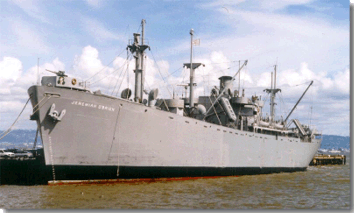|
WW2 Liberty Ships - The Bridge of Steel - Spanning the Atlantic - Linking Britain to America
(see some more pictures here see also this article from the Brunwisk [Georgia] news) Introduction
In the early years of WW2, it was Britain aided by her Dominions, Canada, New Zealand and Australia that stood alone against Germany. To obtain sufficient food to sustain her people, and to import the raw materials to prosecute the war, of necessity, Britain needed to look westwards to North America. The German U-Boat service decimated Britain's Merchant Fleet in the ongoing Battle of the Atlantic. In April of 1941, 800,000 tons of shipping was sent to the bottom of the Atlantic Ocean, by U-Boats, these ships were being sunk at a faster rate than they could be built. In September of 1940, Britain sent a delegation off to the United States with a ship design, and an order for 60 ships, designated as the Ocean Class, of 10,000 tons with a 2,500 horse power engine to produce a speed of 10 knots. This inititive really acted as the catalyst, setting in motion the US move to develop their ship building program, that resulted in the Liberty Ships. US Maritime Commission With the Battle of the Atlantic raging, time was of the essence, if the sea routes across the Atlantic Ocean were to carry sufficient ships loaded with Britain's needs; (a.) to survive and (b.) to build up a supply base to allow for a second front by the invasion of Fortress Europe. President Franklin Roosevelt's Involvement
The President called these ships, "Dreadful looking objects," but in February 1941 announced a construction goal of 200 emergency cargo vessels. This target was soon expanded to 2,300 ships to total 23, 000,000 tons for 1942, and 1943. Admiral Land, in an attempt to upgrade the "Ugly Duckling" image, on the 17th. of September 1941, named it "Liberty Fleet Day" as 14 of these ships were launched across America. Patrick Henry was the first, and provided the impetus for this event, this ship's namesake had said: "Give me Liberty or Death." Britain's first Ocean Ship was launched by the Admiral's wife, Mrs Emory Land, in October 1941, and she named it Ocean Vanguard. German Navy Strategy The big mistake made by Donitz, was to grossly underestimate the ship building capacity, efficiency, and industrial know how of the American ship yards. New building Methods Once the keel was laid, ship sections were fabricated away from the basic slipway, and were then transported to the keel site, and lifted into position by local cranes for assembly onto the hull. Use of Welding Liberty Ship Numbers. What were the dimentions of a Liberty Ship?
Ship Building Workforce Fastest Built Liberty Ship Armament Expected Life Not too many would have believed that these quickly thrown together vessels would outlast every prediction, to become the backbone of the World's Merchant Fleets over the ensuing 25 years. Last two Liberty Ships in existence Book: The Last Liberty
Conclusion I have no doubt, without the wonderful contribution of the United States ship building industry, and the men and women who built the Liberty Ships, victory would have taken much longer, and may not have happened at all. We owe an enormous debt of gratitude to these UGLY DUCKLINGS, who delivered the goods over the years of 1941 -1945. Thank you to all who were involved, the designers, the ship builders, and the crews who manned them in those dark days. WE SALUTE YOU ALL! |

